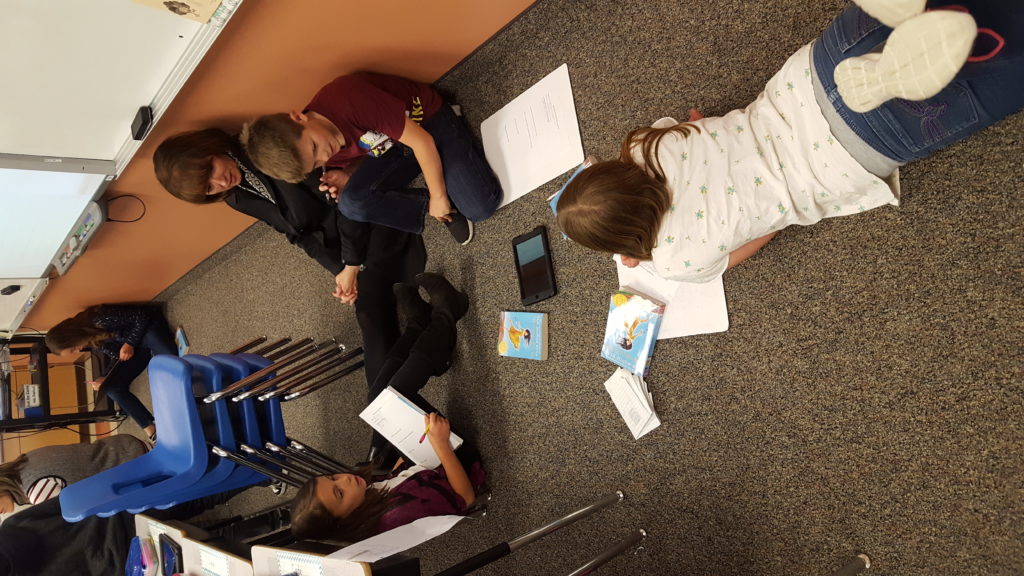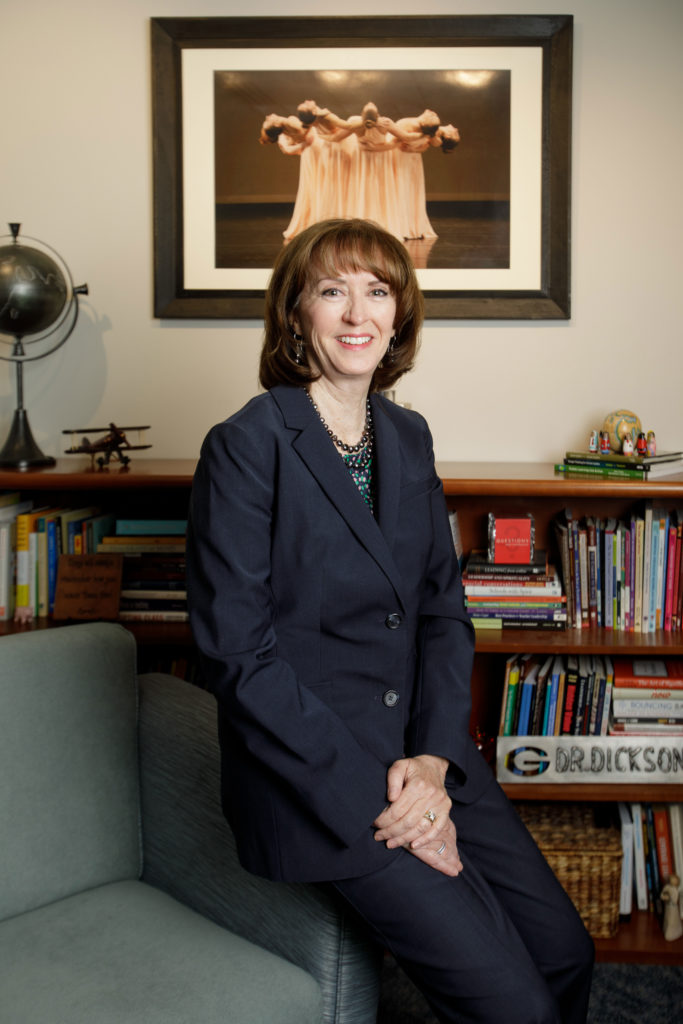A Real World Schooling
Sydnee Dickson ’80, Utah State’s Superintendent of Public Instruction, began her education in a two-room schoolhouse in rural Utah where her grandmother was her teacher.
“My grandmother took ordinary things and made them into magic,” she recalls. “We went from watching trees in the schoolyard to creating beautiful art with crayons, paper, leaves, and an iron.”
A young Dickson was mesmerized by the way her grandmother inspired children to read using Shakespeare. And she adopted the values of the farm community where she grew up.
“Not many people around me were college graduates,” she says. “People worked hard and shared and helped each other. I carried the desire to make a difference by helping others, and that value of hard work, into my college career and far beyond.”

Dickson is known in education circles for her desire to understand how to best serve teachers and students. Photo by Emilie Wheeler.
Dickson went on to earn a doctorate in education leadership and policy at the University of Utah and several additional advanced degrees. But it was an introductory education course at Utah State University’s Emma Eccles Jones College of Education and Human Services where she found her calling, she says. “That was the beginning of my entire career in education.”
“What I admire about Syd’s leadership style is that she visits the schools regularly, in every county, and talks with the students and teachers. This keeps her grounded, I think, and allows her to make measured decisions based on data and the real world of schooling in Utah.” -Sylvia Read, associate dean for teacher education.
Dickson benefited from learning early on to use her voice to confront issues of fairness.
“I was in junior high in the ’70s, when boys could wear blue jeans, but girls could not,” she recalls. “I worked hard to earn money for school clothes; several of my friends and I bought corduroy pants, but we were told that corduroy was too much like denim and we were not allowed to wear the pants. Everyone else gave up, but I went to the principal, found out who the school board members were, and presented my case. The policy was overturned, and we were then allowed to wear the clothes we had carefully saved our money to buy.”
Her experiences as a woman have informed her belief in equity and fairness.
“I often step into all-male arenas to engage with thought partners who share common interests and common goals,” says Dickson. “Sometimes there is a space in between your vision and the vision of the group you interact with. That space in between is fertile ground for learning, relationship building, and negotiation.”
She has served the children of Utah as a proud educator for the past 39 years, first in roles including teaching, school counseling, school administration, and district administration. She joined the Utah State Office of Education in 2007, was named superintendent in 2016, and currently serves on the Board of Trustees for the Council of Chief State School Officers and West Ed Board of Directors.
“I have always been impressed with how Syd is able to effectively handle the complexity of learning organizations; yet she continues to focus on the importance of each child and explore ways to improve learning,” says Parker Fawson, Emma Eccles Jones Endowed Chair in Early Education and Director of the Center for the School of the Future. “This leadership skill produces huge benefits for Utah’s children and ultimately society at large.”
Seeing a need, taking an interest, and then excelling in that field is a defining pattern of Dickson’s life.
“As a teacher, when I started working with struggling kids, I realized I needed more mental health skills, so I became a school counselor,” says Dickson. “As a high school counselor, I saw that most kids had become disconnected in elementary school, so I was inspired to become a principal of an elementary school. There, I noticed the need for teachers to improve their skill sets, and I began studying professional learning. As I designed professional learning curriculums, I started leading in the district office; then I came to the state office with a continued focus on teacher prep and support.”
Dickson’s professional expertise is grounded in engaging parents as partners, providing educators with evidence-based professional learning, and developing transformative school leadership. As superintendent, she is passionate about developing equitable school systems to close achievement gaps and ensure students are prepared to have choices for their future.
“What I admire about Syd’s leadership style is that she visits the schools regularly, in every county, and talks with the students and teachers,” says Sylvia Read, associate dean for teacher education. “This keeps her grounded, I think, and allows her to make measured decisions based on data and the real world of schooling in Utah.”
By Rebecca Dixon ’08
Q+A : USU scholars query Sydnee Dickson on the future of education
Parker Fawson, Director of USU’s Center for the School of the Future
Question: Describe your vision for the future of K-12 schools in Utah.
Answer: Today’s schools continue to be based on many norms of the past, such as calendars, schedules, grades, and content. We are working to create more personalized experiences for each student through a variety of delivery models and a focus on essential competencies. We have also made a shift to focus on the whole child through social/emotional learning and skills that are essential for the workplace and healthy communities. The arts, languages, and humanities are an important fiber that will continue to be woven throughout the K-12 experience.

Sydnee Dickson’s education began in a two-room schoolhouse in rural Utah. Her grandmother was her teacher.
Beth Foley, Dean of the Emma Eccles Jones College of Education and Human Services
Q: What should the future of teacher preparation in Utah look like?
A: Creating systems that are more comprehensive and flexible without overwhelming our educators are some of the challenges as we move forward. While digital tools used by skillful teachers increase our ability to pivot, the power of relationships have never been more important. I am hopeful we will learn from parents’ feedback and embed these elements into the basic fiber of public education. We must address the inequities in our system; both in the digital divide and communication gaps if we are serious about closing learning gaps.
Francine Johnson, Associate Dean for Graduation, Educator Licensing & Accreditation
Q: How do schools move forward after COVID-19 restrictions have been eased, and how does the teacher prep approach need to change?
A: We must be able to pivot according to levels of risk: high, moderate, and low. This applies to both safety and learning. Our teacher candidates need to be part of this equation. For example, think of new teachers entering the profession during a phase of learning at home. How do they establish key relationships, work with colleagues, and get the mentoring and induction support they need? Preparation programs need to be proactive partners in helping design nimble systems and programs.
Sylvia Read, Ph.D. ’00 Professor and Associate Dean for Teacher Education
Q: Are social and emotional aspects of student learning now compelling our attention in new ways?
A: We know more about how trauma impacts the brain and therefore, learning. We must be more intentional about our teachers having awareness and skills in trauma informed practices as well as teaching social and emotional skills in content with intention. We need additional mental health workers in schools and wraparound services need to be more readily available for families.
Q: During the COVID-19 crisis, we have seen the intense challenge of transitioning to remote learning. Do school closures impact younger and/or lower-income students differently?
A: While we don’t have longitudinal data beyond a few months, we already have qualitative data to show differences in age groups and family income levels. For example, younger students aren’t as independent, so parents are critical to the process, yet often feel ill-equipped to work through teaching methodology with their children. Younger students do better when they are able to see their teachers via tech, phone calls, and personal, distanced visits. Daily engagement with literacy and numeracy will continue to be critical.
Our middle school students seemed to become engaged as the education at home has been extended. Academic motivation is generally more challenging with this age group at brick-and-mortar schools as well. Our high school students’ experiences are all over the place. Those who are enrolled in upper division courses seem to have more work added to their plates. Some students have very little work, and many have disengaged. Most concerning are those students and families who are not connected to schools at all. However, overall, our students have done well. This is particularly true for those in districts and charters who participated early on in the Digital Teaching and Learning Initiative. To address these differences, we need to have communication systems in place that help us connect with all families regardless of demographics or geography. We must ensure that every family has access to high-speed internet and effective digital tools with access to teachers who can assist and adapt. Last but certainly not least, every student must have access to mental health workers in our schools and support for more intensive services where needed. Equity is based on both providing individual resources and removing barriers to learning.






